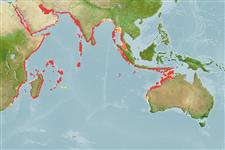>
Tetraodontiformes (Puffers and filefishes) >
Tetraodontidae (Puffers) > Canthigasterinae
Etymology: Canthigaster: Greek, kanthos = the outer or inner corner of the eye, where the lids meet, 1646 + Greek, gaster = stomach (Ref. 45335); cyanospilota: Named for its numerous small bright blue markings..
More on authors: Randall, Williams & Rocha.
Environment: milieu / climate zone / depth range / distribution range
Ecologia
marinhas demersal; intervalo de profundidade 10 - 80 m (Ref. 90102). Subtropical
Indian Ocean: Indian Ocean to the Red Sea and Gulf of Aqaba.
Tamanho / Peso / Idade
Maturity: Lm ? range ? - ? cm
Max length : 10.4 cm SL macho/indeterminado; (Ref. 83660)
Descrição suscinta
Morfologia | Morfometria
Raios dorsais (total): 9-11; Raios anais : 8 - 10; Vértebras: 17. This species is distinguished by the following characters: Dorsal rays 9-11 (modally 9 in the Red Sea); anal rays 8-10 (modally 9); pectoral rays 15-17 (rarely 15); gill rakers 9-10; body depth between origins of dorsal and anal fins 3.15-3.6 in SL; head length (HL) 2.2-2.5 in SL; interorbital width 4.25-4.85 in HL: gill opening length 5.4-6.5 in HL; origin of anal fin below of posterior to rear base of dorsal fin, the preanal length 1.25-1.35 in SL; longest dorsal ray 2.6-2.95 in HL; preserved colour pale grey to pale tan with 3 oblique, saddle-like, brown bars on body, not extending below level of upper end of gill opening a broad dark brown band across posterior interorbital and anterior occiput; head and body dark brown dots and short lines, including ones radiating from eye and margins of brown saddles (also within saddles on Red Sea specimens); dark lines on snout behind mouth vertical; below base of pectoral fin, a dark brown spot; a midventral brown line on head and abdomen; fins pale yellowish; live color with dark dots and lines are bright blue, the caudal fin is conspicuously marked with longitudinal blue lines or rows of small blue spots and short lines, snout is often green dorsally (Ref. 83660).
Inhabits seaward reefs on sand-rubble bottoms in 10-80 m. Solitary (Ref. 90102).
Ciclo de vida ou comportamento de acasalamento
Maturidade | Reprodução | Desova | Ovos | Fecundidade | Larvas
Randall, J.E., J.T. Williams and L.A. Rocha, 2008. The Indo-Pacific tetraodontid fish Canthigaster coronata, a complex of three species. Smithiana, Publ. Aquatic Biodiv. Bull. 9:3-13. (Ref. 83660)
Status na Lista Vermelha da UICN (Ref. 130435)
Ameaça para os humanos
Harmless
Uso pelos humanos
Mais informação
Idade/TamanhoCrescimentoPeso-comprimentoComprimento-comprimentoFrequências de comprimentoMorfometriaMorfologiaLarvasDinâmica larvalRecrutamentoAbundânciaBRUVS
ReferênciasAquaculturaPerfil para aquaculturaEstirpesGenéticaElectrophoresesHereditariedadeDoençasProcessamentoNutrientsConversão de massa
ColaboradoresFotosStamps, Coins Misc.SonsCiguateraVelocidadeTipo de nataçãoÁrea branquialOtólitosCérebrosVisão
Ferramentas
Relatórios especiais
Baixar XML
Fontes da internet
Estimates based on models
Preferred temperature (Ref.
123201): 24.2 - 29.3, mean 27.7 °C (based on 404 cells).
Índice de diversidade filogenética (Ref.
82804): PD
50 = 0.5000 [Uniqueness, from 0.5 = low to 2.0 = high].
Bayesian length-weight: a=0.03631 (0.01554 - 0.08482), b=2.88 (2.69 - 3.07), in cm total length, based on LWR estimates for this Genus-body shape (Ref.
93245).
Nível Trófico (Ref.
69278): 3.1 ±0.4 se; based on size and trophs of closest relatives
Resiliência (Ref.
120179): Elevada, tempo mínimo de duplicação da população menor que 15 meses (Preliminary K or Fecundity.).
Fishing Vulnerability (Ref.
59153): Low vulnerability (10 of 100).
